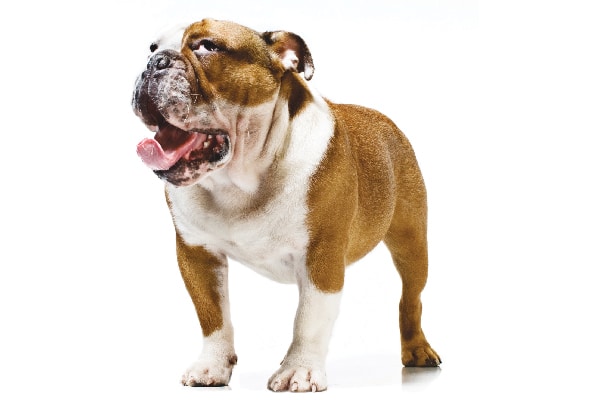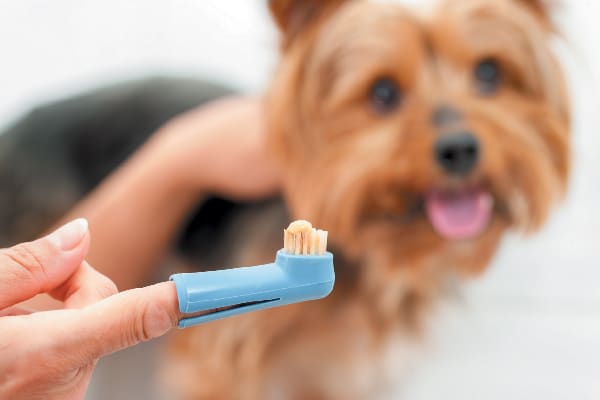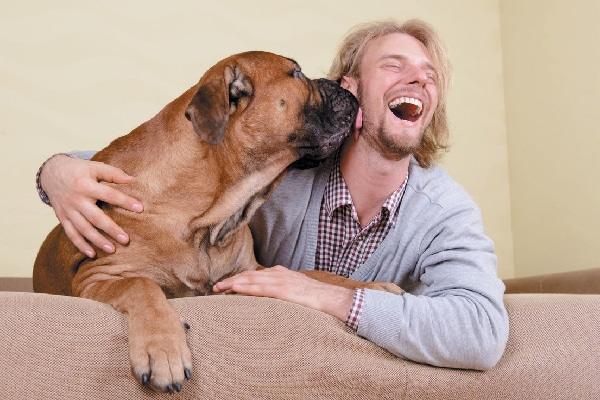You might not want to do that.” I looked up as I felt a gentle hand pull me away. “I don’t really recommend kissing Buttons. Her breath is kind of … let’s just say she could use a breath mint.” If you’ve ever thought (or said aloud), “My dog’s breath smells — why?” you’re not alone!
One of my favorite perks of being a veterinarian is getting kisses from my patients. I love puppy snuggles, kitty headbutts and good, old-fashioned face lickings. Nothing gives me greater joy than the affection of the pets I serve. I wasn’t going to let this whiff warning prevent Buttons and me from smooching.
I leaned in, and Buttons darted forward … and then a gust of rotten eggs and elephant dung plowed me over. I aborted mid-lick.
“Told you.”
My dog’s breath smells — what’s going on inside his mouth?

First, rest assured that you’re hardly the first dog parent who thinks, “My dog’s breath smells!” Bad breath or halitosis is incredibly common in dogs, with about half of all dog owners reporting their dog has “stank mouth.” While most dog lovers are more concerned with stopping the stink, I’m more interested in treating the cause.
Halitosis in dogs is due primarily to oral and systemic causes, with approximately 85 percent of canine bad breath originating in the mouth. Contrary to popular belief (and several misguided products), bad dog breath doesn’t emanate from the intestines or stomach and doesn’t end with enzymes and essences.
Unless your dog is suspected of having a serious condition (see below), most of the stench search will be inside the mouth. Mouth bacteria are responsible for the vast majority of bad breath in dogs. These malodorous microbes thrive within the biofilm of plaque and mineralized calculus they create on a dog’s teeth. The germs then burrow beneath the gums, causing infection and damage to the support structures of teeth. While wreaking havoc in the mouth and gums, these pathogenic bacteria produce the stinky sulfur compounds that cause halitosis. In other words, the short answer to your question, “My dog’s breath smells — why?” is that it’s probably due to mouth bacterial gas. (Maybe I should rethink my pet patient kissing habits.)
I lifted Buttons’ lips, and uncovered a mouth full of dirty teeth and swollen gums, packing a putrid aromatic punch. I held my breath and probed further.
My dog’s breath smells — what else could be at play?
Bad breath in dogs may also be related to oral abscesses, infection or tumors. During my
exam, I discovered Buttons had several loose teeth and signs of severe gingivitis. She had advanced periodontal disease, a condition characterized by red, bleeding gums; calculus; gum recession; and, you guessed it, dragon breath.
My dog’s breath smells — could something outside of his mouth be causing it?
These diseases can cause bad dog breath —
- diabetes (a sickeningly sweet or fruity odor)
- kidney disease (urine or “fishy” ammonia scent)
- liver failure (called “Fetor hepaticus” or “breath of the dead” — seriously)
Treating bad dog breath
Halitosis is a warning that your dog needs better oral care. Simply swishing some mouthwash or offering a breath mint (don’t do either — they can be toxic to dogs) won’t provide any benefit or lasting improvement.
The first step to restoring your dog’s mouth to a kissable state is to have his teeth cleaned by your veterinarian. The only way to effectively and safely clean beneath the gum line requires anesthesia and a trained veterinary professional. Modern anesthetic drugs, monitoring devices, body temperature regulation and specialized equipment make routine dental procedures quick and safe.
I wish we could do a thorough job without the need of anesthesia, but the evidence is clear that anesthesia-free attempts fail to clean where the problem originates: beneath the gums. Further, many dogs are needlessly terrified when poked and prodded with sharp dental instruments while being restrained.
What happened to Buttons’ bad breath?

Buttons returned the next week for a dental cleaning and polishing. Unfortunately, I had to extract three teeth due to extensive root exposure and infection. Buttons’ owner promised to use a combination of daily brushing (at least a few times a week), an oral rinse and a special dental chew containing antimicrobial ingredients.
Three months later, I saw Buttons at a local charity event. As I instinctively leaned over to snuggle, I first checked with her owner. “Is it OK to give her a quick kiss?” “Only after I kiss her first!”
And with that, Buttons gave her pet parent the biggest, sloppiest, most loving lick you’ve ever seen. Their special bond was revitalized, and the ability to express their feelings toward each other returned.
Thumbnail: Photography ©Astakhova | Getty Images.
About the author
Dr. Ernie Ward is an internationally recognized veterinarian known for his innovations in general small-animal practice, long-term medication monitoring, special needs of senior dogs and cats, and pet obesity. He has authored three books and has been a frequent guest on numerous TV programs.
Editor’s note: This article first appeared in Dogster magazine. Have you seen the new Dogster print magazine in stores? Or in the waiting room of your vet’s office? Subscribe now to get Dogster magazine delivered straight to you!






